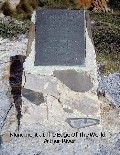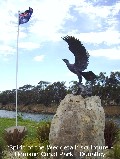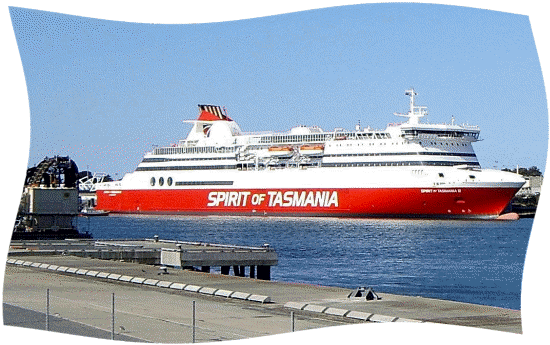
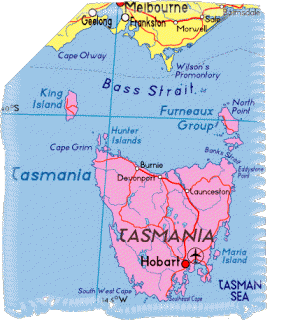
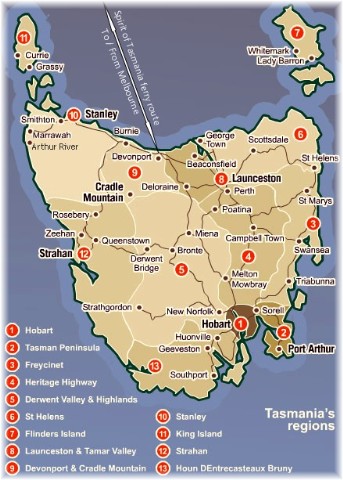
 Tasmania is Australia’s Apple Isle ‘ our historic island state with rugged mountains, magnificent lakes, beaches, rivers, waterfalls and quaint townships with plenty of history, originally named Van Diemen’s Land (1803 ‘ 1856) by early Europeans. I’ve always wanted to visit this idyllic island so my M.O.T.H. (Man Of The House) decided to make my wish come true as his birthday gift to me this year. He made the necessary bookings for a return trip for us to take our motor-home (Just Trip’n) on the passenger and vehicular ferry, ‘Spirit of Tasmania’. We had an early celebratory family lunch at Cho Gao, a Korean restaurant in Melbourne Central on Sunday (the day before our departure) before a bit of a flutter at the Casino afterwards to use up my $40 complimentary voucher. We didn’t win so we came home early to finish some last minute packing, with mounting excitement at the thought of the adventure ahead.
Tasmania is Australia’s Apple Isle ‘ our historic island state with rugged mountains, magnificent lakes, beaches, rivers, waterfalls and quaint townships with plenty of history, originally named Van Diemen’s Land (1803 ‘ 1856) by early Europeans. I’ve always wanted to visit this idyllic island so my M.O.T.H. (Man Of The House) decided to make my wish come true as his birthday gift to me this year. He made the necessary bookings for a return trip for us to take our motor-home (Just Trip’n) on the passenger and vehicular ferry, ‘Spirit of Tasmania’. We had an early celebratory family lunch at Cho Gao, a Korean restaurant in Melbourne Central on Sunday (the day before our departure) before a bit of a flutter at the Casino afterwards to use up my $40 complimentary voucher. We didn’t win so we came home early to finish some last minute packing, with mounting excitement at the thought of the adventure ahead.
Day 1 Nov 12:
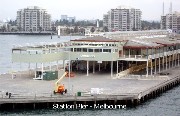 After completing various pre-travel chores and a quick bite of lunch at Macca’s (McDonalds) we stocked up the freezer of ‘Just Trip’n’ with various frozen meals that I had pre-cooked the week before. My MOTH, not wanting to spoil our holiday with me falling off the perch, made sure that I had enough supply of my prescribed medication as well as the travel-sickness pills that his sister had strongly recommended, in case we encountered rough weather during the 11-hour oceangoing ferry ride across Bass Strait. This was followed by a super-early dinner before we eagerly set off for Station Pier at Port Melbourne to board the Spirit of Tasmania, arriving there at 5.20pm.
After completing various pre-travel chores and a quick bite of lunch at Macca’s (McDonalds) we stocked up the freezer of ‘Just Trip’n’ with various frozen meals that I had pre-cooked the week before. My MOTH, not wanting to spoil our holiday with me falling off the perch, made sure that I had enough supply of my prescribed medication as well as the travel-sickness pills that his sister had strongly recommended, in case we encountered rough weather during the 11-hour oceangoing ferry ride across Bass Strait. This was followed by a super-early dinner before we eagerly set off for Station Pier at Port Melbourne to board the Spirit of Tasmania, arriving there at 5.20pm.
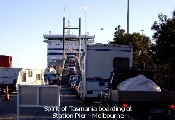 We joined in the loading queue with a gazillion fellow-travelers in various modes of transportation – campervans, caravans, farm trucks, mini buses, motor-homes, all makes and models of motor-cars and 4WDs, vintage cars, etc., and what seemed like at least half the members of Hell’s Angels – from all corners of mainland Australia. Went through the routine security checks and then they tested our patience with the long, long wait before the loading process began. As we patiently waited, we scoffed down a bagful of home grown cherries.
We joined in the loading queue with a gazillion fellow-travelers in various modes of transportation – campervans, caravans, farm trucks, mini buses, motor-homes, all makes and models of motor-cars and 4WDs, vintage cars, etc., and what seemed like at least half the members of Hell’s Angels – from all corners of mainland Australia. Went through the routine security checks and then they tested our patience with the long, long wait before the loading process began. As we patiently waited, we scoffed down a bagful of home grown cherries.
 By 7.15pm, loading smoothly completed, we made our way to our allocated ocean view recliners on Deck 8 and to kill time before the scheduled 8pm departure, we went for a little walkabout on Deck 7, the main hive of activity on board. I bought a souvenir fridge magnet for my collection while my ever-practical MOTH bought a multi-entry pass for the National Parks. On the way back to Deck 8, we happened to stray into the Admiral’s Gaming Lounge… Much to my surprise, my MOTH dipped his hand into his tight pocket, pulled out a $5 note, fed it into a poker machine and told me, ‘Go on! Then you can say that you’ve played the pokies on the ‘Spirit’!’ Before I could open my mouth to thank him, he barked, ‘That’s it though, we’re not staying here all night!’ Needless to say, I quickly punched a few buttons and within minutes, we headed back to Deck 8 with a pocketful of $1 coins – 25 of them, to be exact. We both got our respective iPods happening and comfortably settled into our recliners listening to songs while feeding our faces with Zigzag Twisties‘. It was a fairly smooth ride except for a slightly bumpy session in the middle of Bass Strait but certainly not enough to bring about a chundering performance from me. As luck would have it, my watch strap decided to literally have a break so I was watch-less for the rest of the ride.
By 7.15pm, loading smoothly completed, we made our way to our allocated ocean view recliners on Deck 8 and to kill time before the scheduled 8pm departure, we went for a little walkabout on Deck 7, the main hive of activity on board. I bought a souvenir fridge magnet for my collection while my ever-practical MOTH bought a multi-entry pass for the National Parks. On the way back to Deck 8, we happened to stray into the Admiral’s Gaming Lounge… Much to my surprise, my MOTH dipped his hand into his tight pocket, pulled out a $5 note, fed it into a poker machine and told me, ‘Go on! Then you can say that you’ve played the pokies on the ‘Spirit’!’ Before I could open my mouth to thank him, he barked, ‘That’s it though, we’re not staying here all night!’ Needless to say, I quickly punched a few buttons and within minutes, we headed back to Deck 8 with a pocketful of $1 coins – 25 of them, to be exact. We both got our respective iPods happening and comfortably settled into our recliners listening to songs while feeding our faces with Zigzag Twisties‘. It was a fairly smooth ride except for a slightly bumpy session in the middle of Bass Strait but certainly not enough to bring about a chundering performance from me. As luck would have it, my watch strap decided to literally have a break so I was watch-less for the rest of the ride.
Day 2 Nov 13:
 The ‘Spirit’ docked at Devonport, a major regional centre in north-west Tasmania, situated at the mouth of the Mersey River, at the scheduled time of 7am and we went through another more rigorous security check at the quarantine station. There seemed to be at least half a million diligent quarantine officers and their highly trained dogs checking on all vehicles in compliance with the Tasmanian strict quarantine law against bringing flowers, fresh fruit and vegetables into the island.
The ‘Spirit’ docked at Devonport, a major regional centre in north-west Tasmania, situated at the mouth of the Mersey River, at the scheduled time of 7am and we went through another more rigorous security check at the quarantine station. There seemed to be at least half a million diligent quarantine officers and their highly trained dogs checking on all vehicles in compliance with the Tasmanian strict quarantine law against bringing flowers, fresh fruit and vegetables into the island.
 As soon as we were cleared through the quarantine station, my MOTH made a bee-line for the city centre as his main priority was to buy me a watch so I wouldn’t keep looking at the invisible one on my wrist. We drove over Victoria Bridge to get to the CBD and very quickly located a car park, only to discover that we had to pay for the privilege of parking there – $1 for an hour. My $1 coins from the pokies win thus came in very handy. Not knowing our way about town, we stopped to ask a council worker for directions to the nearest K-Mart, to be told it was situated ‘a couple of blocks up the road – you can’t miss it!’ Off we set on foot and we walked and we walked and we walked’ We finally got to the car-park but of course it was way too early for businesses to start the day’s trading so instead of cooling our heels at the entrance of the shopping centre, we decided to walk back to Just Trip’n and bring her around to the free car-park at the shopping centre. As to be expected, no ‘el cheapo’ watch caught my eye so we temporarily gave up on the watch purchase and bought essential groceries from Woolworths instead.
As soon as we were cleared through the quarantine station, my MOTH made a bee-line for the city centre as his main priority was to buy me a watch so I wouldn’t keep looking at the invisible one on my wrist. We drove over Victoria Bridge to get to the CBD and very quickly located a car park, only to discover that we had to pay for the privilege of parking there – $1 for an hour. My $1 coins from the pokies win thus came in very handy. Not knowing our way about town, we stopped to ask a council worker for directions to the nearest K-Mart, to be told it was situated ‘a couple of blocks up the road – you can’t miss it!’ Off we set on foot and we walked and we walked and we walked’ We finally got to the car-park but of course it was way too early for businesses to start the day’s trading so instead of cooling our heels at the entrance of the shopping centre, we decided to walk back to Just Trip’n and bring her around to the free car-park at the shopping centre. As to be expected, no ‘el cheapo’ watch caught my eye so we temporarily gave up on the watch purchase and bought essential groceries from Woolworths instead. 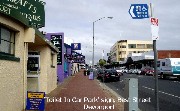 We then drove around looking for a shopping mall and spied one not far from the original council car park, so there goes another of my $1 coins’ We walked for what felt like hours desperately looking for a jewellery store, without any success. Just as I became convinced that Tasmanians aren’t into jewellery, we came across a jewellery store in the Rooke Street Mall where I found an affordable watch I liked and a rather relieved MOTH gladly paid for it. By this time, my MOTH was busting his guts to attend to his morning devotional so we did a quick lap of the Mall before spotting the ‘Toilet in Car Park’ sign boldly displayed on the side of the road. What a relief that was!
We then drove around looking for a shopping mall and spied one not far from the original council car park, so there goes another of my $1 coins’ We walked for what felt like hours desperately looking for a jewellery store, without any success. Just as I became convinced that Tasmanians aren’t into jewellery, we came across a jewellery store in the Rooke Street Mall where I found an affordable watch I liked and a rather relieved MOTH gladly paid for it. By this time, my MOTH was busting his guts to attend to his morning devotional so we did a quick lap of the Mall before spotting the ‘Toilet in Car Park’ sign boldly displayed on the side of the road. What a relief that was!
 At last our exciting road trip was ready to commence.
At last our exciting road trip was ready to commence. 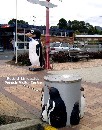 Yay! We both agreed from the start to just drive along and make spontaneous stops wherever and whenever anything of interest catches our eyes. We left Devonport heading north-west following the scenic coastal route and made the first stop at the town of Penguin, (first settled in 1850 as a timber town and named for the Fairy Penguin rookeries common along the less populated parts of the coast) to admire the lovely flowers blooming in profusion in home gardens as well as all along the railway track. Just about everything in this seaside town had a penguin theme, right down to their rubbish bins.
Yay! We both agreed from the start to just drive along and make spontaneous stops wherever and whenever anything of interest catches our eyes. We left Devonport heading north-west following the scenic coastal route and made the first stop at the town of Penguin, (first settled in 1850 as a timber town and named for the Fairy Penguin rookeries common along the less populated parts of the coast) to admire the lovely flowers blooming in profusion in home gardens as well as all along the railway track. Just about everything in this seaside town had a penguin theme, right down to their rubbish bins.  We had yummy beef pies and a can of Coke each before driving on to Burnie (a port city originally settled in 1827 as Emu Bay and renamed in early 1840s after William Burnie, a director of the Van Diemen’s Land Company) to find a chemist for more ‘flu medication for my poor sniffling and coughing MOTH but unwilling to pay any parking fees, we drove on to Wynyard. Wynyard, originally named Table Cape, is a rural town 16km (10miles) west of Burnie notable for the scenic attraction of Table Cape. Oh goody! We found a double car space just outside the chemist and it’s free parking!
We had yummy beef pies and a can of Coke each before driving on to Burnie (a port city originally settled in 1827 as Emu Bay and renamed in early 1840s after William Burnie, a director of the Van Diemen’s Land Company) to find a chemist for more ‘flu medication for my poor sniffling and coughing MOTH but unwilling to pay any parking fees, we drove on to Wynyard. Wynyard, originally named Table Cape, is a rural town 16km (10miles) west of Burnie notable for the scenic attraction of Table Cape. Oh goody! We found a double car space just outside the chemist and it’s free parking!

 From Wynyard, ‘Where Green Meets Blue’ (green landscape meets the blue ocean) we drove towards Smithton (an industrial centre for the surrounding district with a large timber mill and a potato processing plant) but made a little detour to see Table Cape Light Station established in 1888, Van Dieman’s Bulb Farm and the Table Cape Geological Site. [Table Cape is a magnificent example of a weathered volcanic neck which was once a lava lake (hence its flatness) in a volcanic structure in a volcanic terrain.] It was a bit late in the season for the tulips to be in bloom but visitors were not terribly disappointed as it was the flowering season of Dutch iris (from late Sep till early Dec).
From Wynyard, ‘Where Green Meets Blue’ (green landscape meets the blue ocean) we drove towards Smithton (an industrial centre for the surrounding district with a large timber mill and a potato processing plant) but made a little detour to see Table Cape Light Station established in 1888, Van Dieman’s Bulb Farm and the Table Cape Geological Site. [Table Cape is a magnificent example of a weathered volcanic neck which was once a lava lake (hence its flatness) in a volcanic structure in a volcanic terrain.] It was a bit late in the season for the tulips to be in bloom but visitors were not terribly disappointed as it was the flowering season of Dutch iris (from late Sep till early Dec).  Row upon row of the pretty blooms danced gaily in the sea breeze, providing a delightful vision for all to behold.
Row upon row of the pretty blooms danced gaily in the sea breeze, providing a delightful vision for all to behold.  After checking out the historic 25m (82ft) high light station at 190m (623ft) above sea level, we drove a bit further on to the Geological Site as we didn’t feel like taking the walking track to get there. The picturesque scenery of well-fed sheep and gamboling lambs grazing contentedly in a paddock against a background of the vast fields of multi-coloured blooms and the light station with the blue, blue ocean to our right would have been worthy of a Wordsworth poem or a painting by Van Gogh. It would be difficult to find a more delightful view. Alas, being neither poets nor painters, we brought out our cameras instead.
After checking out the historic 25m (82ft) high light station at 190m (623ft) above sea level, we drove a bit further on to the Geological Site as we didn’t feel like taking the walking track to get there. The picturesque scenery of well-fed sheep and gamboling lambs grazing contentedly in a paddock against a background of the vast fields of multi-coloured blooms and the light station with the blue, blue ocean to our right would have been worthy of a Wordsworth poem or a painting by Van Gogh. It would be difficult to find a more delightful view. Alas, being neither poets nor painters, we brought out our cameras instead.
 We eventually left the area and drove to the township of Smithton but there was nothing there that grabbed our attention and besides, there wasn’t a caravan park in sight so we traveled on to Arthur River after making a phone call to confirm the availability of a powered site at the Arthur River Cabin Park. Both the river and the small township were named after Sir George Arthur, Governor of Van Diemen’s Land (1825-1836). We
We eventually left the area and drove to the township of Smithton but there was nothing there that grabbed our attention and besides, there wasn’t a caravan park in sight so we traveled on to Arthur River after making a phone call to confirm the availability of a powered site at the Arthur River Cabin Park. Both the river and the small township were named after Sir George Arthur, Governor of Van Diemen’s Land (1825-1836). We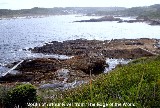 spent the night there and shared the park with a couple of other tourists, a Maltese couple traveling in a caravan that hailed from Melbourne and another couple also traveling in a caravan who have been on the road for the last 18 months. Seeing their spare wheel cover with ‘Di Di Mau’ on it, my MOTH knew the bloke had to be a Vietnam Vet, so the two of them started chin-wagging about their time in ‘Nam while I prepared our simple dinner for the night – a portion of my homemade spaghetti sauce tossed into a saucepan, followed by the contents of a can of Heinz spaghetti, heated up together and slopped onto hot buttered toasts and topped with grated cheese. No dessert tonight, just a few homemade macadamia nut cookies with our coffee. We also shared the $20 a night site with a whole mob of wallabies but by the time I thought of grabbing my camera half an hour later, it was too late as they had moved on. Tried to watch a movie on DVD but all we ended up seeing were the inside of our eyelids!
spent the night there and shared the park with a couple of other tourists, a Maltese couple traveling in a caravan that hailed from Melbourne and another couple also traveling in a caravan who have been on the road for the last 18 months. Seeing their spare wheel cover with ‘Di Di Mau’ on it, my MOTH knew the bloke had to be a Vietnam Vet, so the two of them started chin-wagging about their time in ‘Nam while I prepared our simple dinner for the night – a portion of my homemade spaghetti sauce tossed into a saucepan, followed by the contents of a can of Heinz spaghetti, heated up together and slopped onto hot buttered toasts and topped with grated cheese. No dessert tonight, just a few homemade macadamia nut cookies with our coffee. We also shared the $20 a night site with a whole mob of wallabies but by the time I thought of grabbing my camera half an hour later, it was too late as they had moved on. Tried to watch a movie on DVD but all we ended up seeing were the inside of our eyelids!
 Left Arthur River at 9.15am, decided to forego the Arthur and Franklin Rivers cruise and headed to the Edge of the World landmark instead. After reading the touching poem on the monument, we each cast a pebble into the ocean, snapped a couple of photos, well ok, a dozen or so’ and left the scene. The inscription on the monument:
Left Arthur River at 9.15am, decided to forego the Arthur and Franklin Rivers cruise and headed to the Edge of the World landmark instead. After reading the touching poem on the monument, we each cast a pebble into the ocean, snapped a couple of photos, well ok, a dozen or so’ and left the scene. The inscription on the monument:
North West Coast Tasmania
To be washed by the Ocean of Time.
It has shape, form and substance.
It is me.
One day I will be no more.
But my pebble will remain here.
On the Shore of Eternity.
Mute witness for the aeons.
That today I came and stood.
At the edge of the world.
Brian Inder
 From Arthur River, we went to check out West Point but after only a kilometre up the track, a kind fellow tourist driving from where we were heading to, stopped us to advise that the track further on is pretty rugged – too rough even for his sedan to tackle. After thanking this kind soul profusely, we did a turnaround and set off to check out Woolnorth, only to find out an appointment for a tour of the wind farm has to be pre-arranged! ‘Stuff that idea!’ we muttered as we left the area and went on to Stanley (the last major township on the north-west coast named after Lord Stanley, the British Secretary of State for the Colonies in the 1840s), for a shared lunch of a delicious cray roll, scallop pie and chicken curry pie from Hursey
From Arthur River, we went to check out West Point but after only a kilometre up the track, a kind fellow tourist driving from where we were heading to, stopped us to advise that the track further on is pretty rugged – too rough even for his sedan to tackle. After thanking this kind soul profusely, we did a turnaround and set off to check out Woolnorth, only to find out an appointment for a tour of the wind farm has to be pre-arranged! ‘Stuff that idea!’ we muttered as we left the area and went on to Stanley (the last major township on the north-west coast named after Lord Stanley, the British Secretary of State for the Colonies in the 1840s), for a shared lunch of a delicious cray roll, scallop pie and chicken curry pie from Hursey 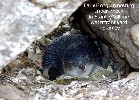 Seafood Restaurant & Takeaway. After lunch, we decided to snap a few photos of our surrounds. The owner of the restaurant saw us taking a photo of
Seafood Restaurant & Takeaway. After lunch, we decided to snap a few photos of our surrounds. The owner of the restaurant saw us taking a photo of  the ‘Big Cray’ atop the building and told us about a nesting fairy penguin under some rocks in the front lawn of Stanley Village Boutique Motel and Restaurant on the waterfront just across the road. Off we trotted with our cameras and got a few photos of the wee penguin. From there we ventured up Circular Head, commonly known as ‘The Nut’ and geologically speaking, is the stump of an old volcano, with steep sides and a flat top, rising 143m (469ft), like a weird box above Sawyer Bay. Climbing ‘The Nut’ is a bit like climbing Uluru (Ayers Rock) and no easy feat as it is a steep and difficult walk that requires fitness and commitment.
the ‘Big Cray’ atop the building and told us about a nesting fairy penguin under some rocks in the front lawn of Stanley Village Boutique Motel and Restaurant on the waterfront just across the road. Off we trotted with our cameras and got a few photos of the wee penguin. From there we ventured up Circular Head, commonly known as ‘The Nut’ and geologically speaking, is the stump of an old volcano, with steep sides and a flat top, rising 143m (469ft), like a weird box above Sawyer Bay. Climbing ‘The Nut’ is a bit like climbing Uluru (Ayers Rock) and no easy feat as it is a steep and difficult walk that requires fitness and commitment.
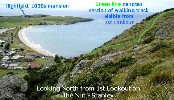 Anyway, we decided to make our way, very slowly, I might add, up the steep walking track to reach the top and were rewarded with magnificent views of the peninsula and its surrounds (including the gracious 1830s Highfield mansion built for Van Diemen’s Land Company chief agent, Edward Curr, on the next headland), from the two strategically-erected lookout platforms. It wasn’t easy trying to handle our respective cameras and take photos while tightly hanging on to the railing for fear of being blown away by the freezing cold gale force winds but somehow, we managed.
Anyway, we decided to make our way, very slowly, I might add, up the steep walking track to reach the top and were rewarded with magnificent views of the peninsula and its surrounds (including the gracious 1830s Highfield mansion built for Van Diemen’s Land Company chief agent, Edward Curr, on the next headland), from the two strategically-erected lookout platforms. It wasn’t easy trying to handle our respective cameras and take photos while tightly hanging on to the railing for fear of being blown away by the freezing cold gale force winds but somehow, we managed. 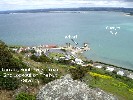 By the time we made our way back to level ground via the same steep track, my knees were trembling and wobbly but I felt triumphant at having made the climb. Not only did we get some much needed exercise but we also saved $20 (cost of chair-lift for 2 adults)! We spent the night at Stanley Cabin and Tourist Park ($22 per night) situated with The Nut on one side and the beach of the tranquil Sawyer Bay on the other. We had a very short leisurely stroll to the beach before a nice hot shower and dinner of boneless lamb roast with baked potatoes, carrots and gravy. Dessert was mulberry yoghurt, made by mixing home stewed mulberries in tub of plain natural yoghurt. Yum! Brief moment of panic when I started my laptop to jot down today’s events as the battery of my laptop showed it wasn’t charging. After several attempts at re-booting, it finally dawned on me that I hadn’t plugged in the power cord. Doh!
By the time we made our way back to level ground via the same steep track, my knees were trembling and wobbly but I felt triumphant at having made the climb. Not only did we get some much needed exercise but we also saved $20 (cost of chair-lift for 2 adults)! We spent the night at Stanley Cabin and Tourist Park ($22 per night) situated with The Nut on one side and the beach of the tranquil Sawyer Bay on the other. We had a very short leisurely stroll to the beach before a nice hot shower and dinner of boneless lamb roast with baked potatoes, carrots and gravy. Dessert was mulberry yoghurt, made by mixing home stewed mulberries in tub of plain natural yoghurt. Yum! Brief moment of panic when I started my laptop to jot down today’s events as the battery of my laptop showed it wasn’t charging. After several attempts at re-booting, it finally dawned on me that I hadn’t plugged in the power cord. Doh!
Day 4 Nov 15:
We left Stanley at 9.30am and headed for Devonport, stopping at Sisters Beach for brunch of hastily assembled curried egg sandwiches before continuing on to Wynyard to get bread (free parking!). 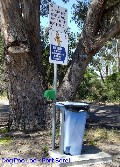 From there, we followed the coastal road back through Burnie and Devonport, continuing on to Port Sorell, a sleepy holiday retreat for boating and fishing enthusiasts, stopping at a roadside fruit barn for apples and garlic. We checked out Squeaking Point but there wasn’t much there except for a little jetty and three blokes fishing.
From there, we followed the coastal road back through Burnie and Devonport, continuing on to Port Sorell, a sleepy holiday retreat for boating and fishing enthusiasts, stopping at a roadside fruit barn for apples and garlic. We checked out Squeaking Point but there wasn’t much there except for a little jetty and three blokes fishing. 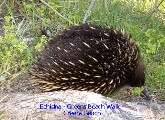 We travelled on through the Dazzler Range to Beaconsfield but didn’t make a stop. It was onwards to Greens Beach for us to check in at the Greens Beach Caravan Park where we would be spending the night. After connecting Just Trip’n to the power supply, we went for a ‘short’ 2-hour return walk along the coastal trail, where I caught sight of an echidna in the act of scrounging around for its dinner. Quick as a flash, I whipped out my camera and managed to capture a couple of shots before it beat a hasty retreat into the bush. As our walk progressed and as we reached each turn of the trail, all we saw were more blooming rocks so decided to call it a day. We would check out the West Head Lookout in the morning on our way out of town. Dinner tonight consisted of yummy South Australian gourmet beef sausages and fried onions on bread, followed by dessert of crisp Royal Gala apples before settling in with a movie on DVD.
We travelled on through the Dazzler Range to Beaconsfield but didn’t make a stop. It was onwards to Greens Beach for us to check in at the Greens Beach Caravan Park where we would be spending the night. After connecting Just Trip’n to the power supply, we went for a ‘short’ 2-hour return walk along the coastal trail, where I caught sight of an echidna in the act of scrounging around for its dinner. Quick as a flash, I whipped out my camera and managed to capture a couple of shots before it beat a hasty retreat into the bush. As our walk progressed and as we reached each turn of the trail, all we saw were more blooming rocks so decided to call it a day. We would check out the West Head Lookout in the morning on our way out of town. Dinner tonight consisted of yummy South Australian gourmet beef sausages and fried onions on bread, followed by dessert of crisp Royal Gala apples before settling in with a movie on DVD.
Day 5 Nov 16:
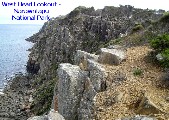
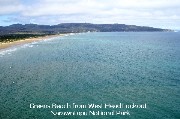 We left Greens Beach Caravan Park about 8.30am and drove through Narawntapu National Park to get to the West Head Lookout for a bit of a ‘look-see’ and a hundred clicks of our cameras later, we drove on to view Garden Island just outside of Kelso. To our great disappointment, all we could see was a sewerage farm so we gave up in disgust. We then drove to Beaconsfield, near the Tamar River, north of Launceston, for a look around the gold mine that collapsed on April 25th 2006.
We left Greens Beach Caravan Park about 8.30am and drove through Narawntapu National Park to get to the West Head Lookout for a bit of a ‘look-see’ and a hundred clicks of our cameras later, we drove on to view Garden Island just outside of Kelso. To our great disappointment, all we could see was a sewerage farm so we gave up in disgust. We then drove to Beaconsfield, near the Tamar River, north of Launceston, for a look around the gold mine that collapsed on April 25th 2006.
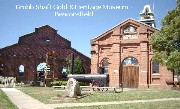
 Beaconsfield was originally known as Cabbage Tree Hill and when gold-mining began in the 1870s, it became known as ‘Brandy Creek’ and later renamed in 1879 in honour of Benjamin Disraeli, Earl of Beaconsfield, the then Prime Minister of Great Britain. Afterwards, we had a leisurely walk around the historic park across the road to admire the beautiful roses in full bloom growing in
Beaconsfield was originally known as Cabbage Tree Hill and when gold-mining began in the 1870s, it became known as ‘Brandy Creek’ and later renamed in 1879 in honour of Benjamin Disraeli, Earl of Beaconsfield, the then Prime Minister of Great Britain. Afterwards, we had a leisurely walk around the historic park across the road to admire the beautiful roses in full bloom growing in 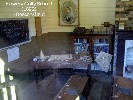 profusion there. We took our time wandering around breathing in the rose-scented air while we peered through the windows of the rebuilt/restored old miner’s cottage, the Flowery Gully School (a one teacher school built in 1892) and an itty bitty general store
profusion there. We took our time wandering around breathing in the rose-scented air while we peered through the windows of the rebuilt/restored old miner’s cottage, the Flowery Gully School (a one teacher school built in 1892) and an itty bitty general store ![]() stocked with products of the period. To satisfy our rumblingtummies, we ended our walkabout and headed across the road to buy lunch of crumbed Blue Grenadier fillets and chips. As soon as they were devoured, my MOTH cranked up the engine of Just Trip’n and made our way to Beauty Point to check out Seahorse World. Just as my MOTH drew out his wallet for the $40 entry fee
stocked with products of the period. To satisfy our rumblingtummies, we ended our walkabout and headed across the road to buy lunch of crumbed Blue Grenadier fillets and chips. As soon as they were devoured, my MOTH cranked up the engine of Just Trip’n and made our way to Beauty Point to check out Seahorse World. Just as my MOTH drew out his wallet for the $40 entry fee 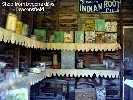 for 2 adults, he read the sign that said, ‘Strictly no photography including digital and video cameras!’ so back the money went into his wallet.
for 2 adults, he read the sign that said, ‘Strictly no photography including digital and video cameras!’ so back the money went into his wallet.  ‘Don’t seem to be much point in forking out big bucks if we can’t take any photos!’ we voiced in unison. We marched back to Just Trip’n in disgust and drove back through Beaconsfield just so I could take a photo of the Exchange Hotel, the hub of activity during the miners’ rescue mission in 2006.
‘Don’t seem to be much point in forking out big bucks if we can’t take any photos!’ we voiced in unison. We marched back to Just Trip’n in disgust and drove back through Beaconsfield just so I could take a photo of the Exchange Hotel, the hub of activity during the miners’ rescue mission in 2006.
That done, we continued on our way, going over the Batman Bridge to get to the 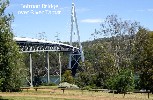
 other side of the Tamar River so we could get to Georgetown, Australia’s oldest town. We drove up the steep road on Mount George to the Lookout and the historic Semaphore Station. From the Lookout we could see for miles so we spent some time there pointing out to each other the various places that we’ve just visited. From Mount George we drove on to Low Head to check out the Low Head Lighthouse. This signal station was set up in 1805 and is Australia’s oldest continuously used pilot station
other side of the Tamar River so we could get to Georgetown, Australia’s oldest town. We drove up the steep road on Mount George to the Lookout and the historic Semaphore Station. From the Lookout we could see for miles so we spent some time there pointing out to each other the various places that we’ve just visited. From Mount George we drove on to Low Head to check out the Low Head Lighthouse. This signal station was set up in 1805 and is Australia’s oldest continuously used pilot station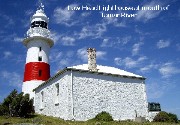 and the light-station established in 1833 was Australia’s third and Tasmania’s second.
and the light-station established in 1833 was Australia’s third and Tasmania’s second. 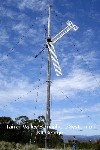 We ended the day’s tour at Bridport Caravan Park with the intention of picking up the remaining first day’s play of the 2nd cricket test match between Australia and Sri Lanka. As soon as we could, we wound up the TV antenna and watched the live telecast instead of listening to the live commentary on ABC radio as we had to while on the road. Tonight’s dinner is Lamb Tomato Curry and Rice followed by coffee and cookies. Both of us were full to the gunnels so skipped dessert. We unwound with a TV movie, ‘Paycheck’ before surrendering to sweet slumber to the sound of waves gently lapping the shore.
We ended the day’s tour at Bridport Caravan Park with the intention of picking up the remaining first day’s play of the 2nd cricket test match between Australia and Sri Lanka. As soon as we could, we wound up the TV antenna and watched the live telecast instead of listening to the live commentary on ABC radio as we had to while on the road. Tonight’s dinner is Lamb Tomato Curry and Rice followed by coffee and cookies. Both of us were full to the gunnels so skipped dessert. We unwound with a TV movie, ‘Paycheck’ before surrendering to sweet slumber to the sound of waves gently lapping the shore.
Day 6 Nov 17:
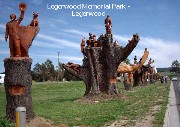 At 9.15 the next morning, we left Bridport, a popular holiday and commercial fishing location, to go to Scottsdale before continuing south to St Helens.
At 9.15 the next morning, we left Bridport, a popular holiday and commercial fishing location, to go to Scottsdale before continuing south to St Helens. Scottsdale didn’t merit a stop except for a very brief one at a roadside fruit vendor to purchase half a kilo each of apricots and nectarines. We continued on the Tasman Highway, merrily chomping on our late breakfast of the fresh stone fruit until a sign pointing to Ralphs Falls caught our eyes, whereupon, a quick turn of the steering wheel took us off the highway and into the Legerwood turn-off. Just as we entered the little township of Legerwood, a most unusual sight in the main street brought us to a screeching halt. We joined many other tourists to admire some pretty amazing wood sculptures done on nine old tree stumps in the Legerwood Memorial Park, in memory of the town’s fallen war heroes.
Scottsdale didn’t merit a stop except for a very brief one at a roadside fruit vendor to purchase half a kilo each of apricots and nectarines. We continued on the Tasman Highway, merrily chomping on our late breakfast of the fresh stone fruit until a sign pointing to Ralphs Falls caught our eyes, whereupon, a quick turn of the steering wheel took us off the highway and into the Legerwood turn-off. Just as we entered the little township of Legerwood, a most unusual sight in the main street brought us to a screeching halt. We joined many other tourists to admire some pretty amazing wood sculptures done on nine old tree stumps in the Legerwood Memorial Park, in memory of the town’s fallen war heroes.
Having taken a dozen or so photos of this rather unique local landmark, we jumped back into Just Trip’n and continued on our 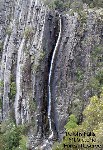 way to Ralphs Falls. This little adventure involved an 11km (7 miles) winding drive up Mount Victoria on a rather narrow and rugged gravel road with many a hair-raising turn, accompanied by some pretty colourful l
way to Ralphs Falls. This little adventure involved an 11km (7 miles) winding drive up Mount Victoria on a rather narrow and rugged gravel road with many a hair-raising turn, accompanied by some pretty colourful l anguage intermittently making its way out from between the MOTH’s grimly clenched teeth. It was such a relief when we finally reached our destination. We then took a 25-minute return walk to Norm’s Lookout to view the falls. Ralphs Falls is the tallest single drop fall, plunging some 100m (328ft) off a cliff. The view of the green valley so far below brought home to us just how very high up we had driven. The walk down to the Lookout was pretty easy and took us about 10 mins but couldn’t say the same about the return walk though – mostly uphill so it took us longer to get back to the car-park and by the time we reached there, I was a tad puffed.
anguage intermittently making its way out from between the MOTH’s grimly clenched teeth. It was such a relief when we finally reached our destination. We then took a 25-minute return walk to Norm’s Lookout to view the falls. Ralphs Falls is the tallest single drop fall, plunging some 100m (328ft) off a cliff. The view of the green valley so far below brought home to us just how very high up we had driven. The walk down to the Lookout was pretty easy and took us about 10 mins but couldn’t say the same about the return walk though – mostly uphill so it took us longer to get back to the car-park and by the time we reached there, I was a tad puffed.
Instead of going back the way we came, I convinced the MOTH to continue on the gravel road to the township of 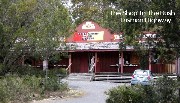 Pyengana which I secretly hoped would be a better option, thus saving us the harrowing drive back down the mountain. How glad I was that it was a good decision. We passed the historical ‘Pub in the Paddock’ but unfortunately, did not stop to take a photo of it as we didn’t realize its significance until it was too late to turn around and go back. Further along the Tasman Highway we stopped so I could take a photo of the ‘Shop In The Bush’, a bric-a-brac shop specializing in books, antiques, china, crystal and jewellery, standing proudly on the side of the highway, in the middle of nowhere.
Pyengana which I secretly hoped would be a better option, thus saving us the harrowing drive back down the mountain. How glad I was that it was a good decision. We passed the historical ‘Pub in the Paddock’ but unfortunately, did not stop to take a photo of it as we didn’t realize its significance until it was too late to turn around and go back. Further along the Tasman Highway we stopped so I could take a photo of the ‘Shop In The Bush’, a bric-a-brac shop specializing in books, antiques, china, crystal and jewellery, standing proudly on the side of the highway, in the middle of nowhere.
We continued on our journey to St Helens (the largest fishing port and town on the east coast, said to be the birthplace of screen legend Merle Oberon), where we  stopped to buy lunch at the Captain’s Catch seafood caf’ on the waterfront. Clutching our mouth-watering battered Gemfish and chips, we headed back to Just Trip’n to get out of the wind and enjoy our lunch but just as I got the door opened, a blooming seagull flew past and shat on my right arm! Oh well, maybe it was a good omen’ We washed down our lunch with icy cold Coke before we sallied forth for the next township as neither of us was interested in what St Helens had to offer.
stopped to buy lunch at the Captain’s Catch seafood caf’ on the waterfront. Clutching our mouth-watering battered Gemfish and chips, we headed back to Just Trip’n to get out of the wind and enjoy our lunch but just as I got the door opened, a blooming seagull flew past and shat on my right arm! Oh well, maybe it was a good omen’ We washed down our lunch with icy cold Coke before we sallied forth for the next township as neither of us was interested in what St Helens had to offer.
On the way to the next township of St Marys, the MOTH impulsively decided to check out Mount Elephant, specifically, Elephant Pass, so up the 8km (5 miles) winding road we went. Luckily, it was bitumen all the way. This cheered the MOTH somewhat and put him in a happier frame of mind. As we drove on further and further up Mount Elephant, we came across a road sign that advised ‘Large Vehicles Sound Your Horn’ just before each bend in the road, so my MOTH happily complied despite my opinion that the signage are meant for big heavy trucks but upon seeing his gleeful boyish grin it was hard to stay serious. So on and on we continued to drive until we finally arrived at the Pancake Cottage situated about midway on Elephant Pass. We pulled into the car park of the somewhat ordinary-looking country cottage caf’, gave the posted menu outside a cursory glance and did a turnaround to get back on the Elephant Pass, back down the winding road to the Tasman Highway.
No more detours for the day as we drove past the tiny township of St Marys with its population of 549 (2001 census) and onwards to the seaside township of Bicheno where we will spend the night at the Seaview Holiday Park. Once settled, we were again able to follow the live telecast of day 2 of the Cricket test match. Dinner tonight was fried eggs on toast as we weren’t terribly hungry after such a hearty lunch.
Day 7 Nov 18:
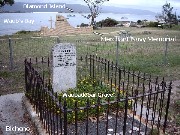 We drove out of the caravan park around 9-ish and went to check out places of interest in Bicheno, (primarily a fishing port, named after James Evernezer Bicheno, the British Colonial Secretary
We drove out of the caravan park around 9-ish and went to check out places of interest in Bicheno, (primarily a fishing port, named after James Evernezer Bicheno, the British Colonial Secretary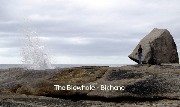 1843-1851) before our departure from this East Coast township. First, we checked out the diamond-shaped island just outside of town, funnily enough, named ‘Diamond Island’. We then went to Waubedebar’s Grave – Waubedebar was an aboriginal who was stolen from her tribe as a teenager to become a “sealer’s woman”. Her bravery in swimming out to rescue sealers caught in a storm is commemorated by a headstone. The Merchant Navy Memorial is situated in the same park overlooking Waub’s Bay. From the park, we drove to the next place of interest, the Blow Hole.
1843-1851) before our departure from this East Coast township. First, we checked out the diamond-shaped island just outside of town, funnily enough, named ‘Diamond Island’. We then went to Waubedebar’s Grave – Waubedebar was an aboriginal who was stolen from her tribe as a teenager to become a “sealer’s woman”. Her bravery in swimming out to rescue sealers caught in a storm is commemorated by a headstone. The Merchant Navy Memorial is situated in the same park overlooking Waub’s Bay. From the park, we drove to the next place of interest, the Blow Hole.  What an impressive sight it was, of waves pounding into the rocks and gushing out of the blow hole in a huge spray’ and it wasn’t even high tide, thus revealing the kelp bed close to the shore. From there, we back-tracked to the Governor Island Marine Reserve and the channel of water between Governor Island and the mainland called The Gulch. There were at least a million water birds flying around cawing and squawking away to their hearts’ content and loud enough to wake the dead!
What an impressive sight it was, of waves pounding into the rocks and gushing out of the blow hole in a huge spray’ and it wasn’t even high tide, thus revealing the kelp bed close to the shore. From there, we back-tracked to the Governor Island Marine Reserve and the channel of water between Governor Island and the mainland called The Gulch. There were at least a million water birds flying around cawing and squawking away to their hearts’ content and loud enough to wake the dead!
Leaving Bicheno behind us, we traveled south to Coles Bay, a town on a beautiful bay of the same name on the Freycinet Peninsula, the entrance to Freycinet National Park. 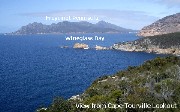 So up we went on yet another mountainous fairly winding road to the Cape Tourville Lookout to be awed by magnificent views of Carp Bay and Thouin Bay with numerous buoys marking what we assumed to be crayfish pots. A hundred or so of photos later, we drove back down to the township of Coles Bay and onwards to rejoin the Tasman Highway. On the way in, a roadside sign on Coles Bay Road advertising ‘Freycinet Marine Farm – Fresh Oysters and Mussels’ caught our eyes so we decided to stop there on the way out. How pleased we were with this decision as we sat down to a scrumptious lunch of a dozen large freshly shucked Pacific oysters and a huge bowl of steamed mussels served with slices of lemon. Ah’ this is the life!
So up we went on yet another mountainous fairly winding road to the Cape Tourville Lookout to be awed by magnificent views of Carp Bay and Thouin Bay with numerous buoys marking what we assumed to be crayfish pots. A hundred or so of photos later, we drove back down to the township of Coles Bay and onwards to rejoin the Tasman Highway. On the way in, a roadside sign on Coles Bay Road advertising ‘Freycinet Marine Farm – Fresh Oysters and Mussels’ caught our eyes so we decided to stop there on the way out. How pleased we were with this decision as we sat down to a scrumptious lunch of a dozen large freshly shucked Pacific oysters and a huge bowl of steamed mussels served with slices of lemon. Ah’ this is the life!
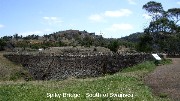 After lunch it was back onto the Tasman Highway heading south, driving through the township of Swansea and making a brief stop to check out Spiky Bridge, a convict bridge built in 1843, 7.5km (4.7 miles) south of Swansea, constructed from fieldstones laid without mortar or cement. This unusual bridge wasn’t named after anyone of importance but rather because of the fieldstones laid vertically on the parapet like spikes, supposedly, to prevent cattle from falling over the sides.
After lunch it was back onto the Tasman Highway heading south, driving through the township of Swansea and making a brief stop to check out Spiky Bridge, a convict bridge built in 1843, 7.5km (4.7 miles) south of Swansea, constructed from fieldstones laid without mortar or cement. This unusual bridge wasn’t named after anyone of importance but rather because of the fieldstones laid vertically on the parapet like spikes, supposedly, to prevent cattle from falling over the sides. 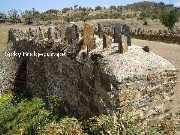 We reached historic Triabunna (an Aboriginal Tasmanian word for the endemic Tasmanian native hen), the largest township on the east coast, sheltered within Spring Bay at the mouth of MacCleans Creek and Vickerys Rivulet which started as a garrison town for the penal colony on Maria Island. We checked into the Triabunna Caravan Park just in time to catch the live telecast of Day 3 post afternoon tea play of the Cricket Test match.
We reached historic Triabunna (an Aboriginal Tasmanian word for the endemic Tasmanian native hen), the largest township on the east coast, sheltered within Spring Bay at the mouth of MacCleans Creek and Vickerys Rivulet which started as a garrison town for the penal colony on Maria Island. We checked into the Triabunna Caravan Park just in time to catch the live telecast of Day 3 post afternoon tea play of the Cricket Test match.
 When the televised cricket match ended for the day, we grabbed the town walk visitor’s guide that we had acquired earlier from the Visitor Information Centre and went for a stroll along the Esplanade with a view of Dead Island (Isle of the Dead) which was used as a burial ground for twenty years (1847-1867). Continuing on our walkabout, we checked out the historic Spring Bay Hotel which was built in 1861 and originally known as Pembroke Hotel. Next on the list was the Old Barracks & Stables, built by George Rudd in 1843 when the 51st
When the televised cricket match ended for the day, we grabbed the town walk visitor’s guide that we had acquired earlier from the Visitor Information Centre and went for a stroll along the Esplanade with a view of Dead Island (Isle of the Dead) which was used as a burial ground for twenty years (1847-1867). Continuing on our walkabout, we checked out the historic Spring Bay Hotel which was built in 1861 and originally known as Pembroke Hotel. Next on the list was the Old Barracks & Stables, built by George Rudd in 1843 when the 51st 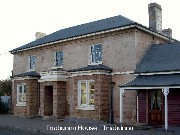 Regiment from Maria Island was stationed at Spring Bay. A few yards further on stood Triabunna House which was originally built as a hotel and became the Robertson’s family residence in 1875. Later on, it operated as a boarding house (from 1906 to the 1930s) as Misses Robertson’s Boarding House. The Colonial House, the present day Sufi’s Craft Shop & Tea Rooms, was once the home of the McGrath Family built in the 1880s. When we got to a little takeaway shop across the road from Sufi’s, we decided to have a takeaway dinner – hamburgers with the lot, minus bacon, of course. On the way back, we passed the Magistrate’s Cottage, built in the 1840s and used until 1861.
Regiment from Maria Island was stationed at Spring Bay. A few yards further on stood Triabunna House which was originally built as a hotel and became the Robertson’s family residence in 1875. Later on, it operated as a boarding house (from 1906 to the 1930s) as Misses Robertson’s Boarding House. The Colonial House, the present day Sufi’s Craft Shop & Tea Rooms, was once the home of the McGrath Family built in the 1880s. When we got to a little takeaway shop across the road from Sufi’s, we decided to have a takeaway dinner – hamburgers with the lot, minus bacon, of course. On the way back, we passed the Magistrate’s Cottage, built in the 1840s and used until 1861.  Enough exercise for one day, we decided, so back we went to the Caravan Park to wolf down our ‘burgers, followed by a long hot shower before settling in for the night with the MOTH watching TV while I re-capped today’s events on my laptop. On the stroke of midnight, my MOTH handed me a cute hand-made birthday card he had painstakingly drawn while I was busy with my daily report. All the walking we’d done meant we had no trouble going to sleep that night, heading off to slumber-land as soon as our heads touched our pillows. In the morning, we’ll be continuing our southbound journey to Port Arthur on the Tasman Peninsula!
Enough exercise for one day, we decided, so back we went to the Caravan Park to wolf down our ‘burgers, followed by a long hot shower before settling in for the night with the MOTH watching TV while I re-capped today’s events on my laptop. On the stroke of midnight, my MOTH handed me a cute hand-made birthday card he had painstakingly drawn while I was busy with my daily report. All the walking we’d done meant we had no trouble going to sleep that night, heading off to slumber-land as soon as our heads touched our pillows. In the morning, we’ll be continuing our southbound journey to Port Arthur on the Tasman Peninsula!
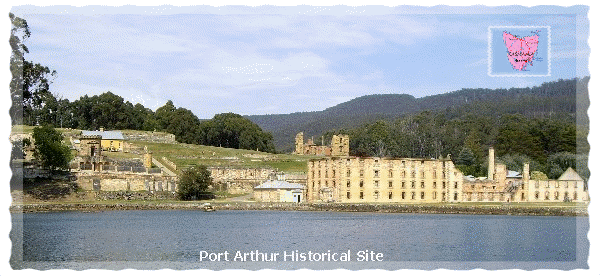
 I woke up on my birthday to another glorious Tasmanian morning and after receiving a phone call with warm birthday wishes from my son, we drove out of Triabunna at 9.15am to get to our next destination, the Tasman Peninsula. As we reached the coastal hamlet of Orford, centred around the mouth of the Prosser River, both the MOTH and I just about choked with the stench in the air – I was convinced that all of the town folks must have had a damn good feed of curried eggs, baked beans and cabbage the previous night and simultaneously dropped their guts just as we drove past! We couldn’t get out of town fast enough.
I woke up on my birthday to another glorious Tasmanian morning and after receiving a phone call with warm birthday wishes from my son, we drove out of Triabunna at 9.15am to get to our next destination, the Tasman Peninsula. As we reached the coastal hamlet of Orford, centred around the mouth of the Prosser River, both the MOTH and I just about choked with the stench in the air – I was convinced that all of the town folks must have had a damn good feed of curried eggs, baked beans and cabbage the previous night and simultaneously dropped their guts just as we drove past! We couldn’t get out of town fast enough.
 After passing the township of Buckland, on our approach to the township of Runnymede, we passed two unusually named hills: Break-Me-Neck Hill and then a little further on, Bust-Me-Gall Hill, both with incredibly steep inclines and declines. It is believed that early settlers and travelers used these terms to describe the steep hills and the names simply stuck. Just as we got to Sorell, our mobile phone rang again, this time it was a birthday call from Nina. Soon afterwards, I received an SMS from Sharon wishing me a very happy birthday.
After passing the township of Buckland, on our approach to the township of Runnymede, we passed two unusually named hills: Break-Me-Neck Hill and then a little further on, Bust-Me-Gall Hill, both with incredibly steep inclines and declines. It is believed that early settlers and travelers used these terms to describe the steep hills and the names simply stuck. Just as we got to Sorell, our mobile phone rang again, this time it was a birthday call from Nina. Soon afterwards, I received an SMS from Sharon wishing me a very happy birthday. 
 From Sorell, we took the Arthur Highway and made a brief stop at Dunalley to learn a little more about the Denison Canal. Dunalley is a small fishing village south-east of Hobart en route to Port Arthur, located on a narrow isthmus that joins the Forestier and Tasman Peninsulas to the island of Tasmania. The Denison Canal project of joining Frederick Henry Bay and Blackman Bay began in 1901 when it was hand-dug and finally completed in 1905. The Canal has a swing bridge for road traffic and allows boats easy access between the two bays.
From Sorell, we took the Arthur Highway and made a brief stop at Dunalley to learn a little more about the Denison Canal. Dunalley is a small fishing village south-east of Hobart en route to Port Arthur, located on a narrow isthmus that joins the Forestier and Tasman Peninsulas to the island of Tasmania. The Denison Canal project of joining Frederick Henry Bay and Blackman Bay began in 1901 when it was hand-dug and finally completed in 1905. The Canal has a swing bridge for road traffic and allows boats easy access between the two bays.  Local legend has it that the ‘toll’ to the gatekeeper used to be a bottle of beer. In 1965 a new hydraulic swing bridge replaced the original bridge. We then continued on to the Tasman National Park Lookout on the Forestier Peninsula, just before Eaglehawk Neck (a narrow isthmus about 400m (1312ft) long and under 30m (98ft) wide at its narrowest point making it a natural gateway to the Tasman Peninsula), to admire great views of Pirates Bay before proceeding to view the Tessellated Pavement.
Local legend has it that the ‘toll’ to the gatekeeper used to be a bottle of beer. In 1965 a new hydraulic swing bridge replaced the original bridge. We then continued on to the Tasman National Park Lookout on the Forestier Peninsula, just before Eaglehawk Neck (a narrow isthmus about 400m (1312ft) long and under 30m (98ft) wide at its narrowest point making it a natural gateway to the Tasman Peninsula), to admire great views of Pirates Bay before proceeding to view the Tessellated Pavement.
 The Tessellated Pavement is a rare sedimentary rock formation caused by erosion, so named because it fractures into blocks that appear like tiles, with ‘pans’ and ‘loaves’ features.
The Tessellated Pavement is a rare sedimentary rock formation caused by erosion, so named because it fractures into blocks that appear like tiles, with ‘pans’ and ‘loaves’ features.  [Away from the seashore, the pavement dries out for longer periods at low tide, allowing greater development of salt crystals. The salt that forms on the surface erodes the pavement’s surface quicker than the joints, resulting in the surface of the pavement being lowered while the joints which erode more slowly become rims, giving the appearance of ‘pans’. ‘Loaves’ features occur when the joints are eroding quicker than the surface because of abrasion by sand and other particles carried by water.]
[Away from the seashore, the pavement dries out for longer periods at low tide, allowing greater development of salt crystals. The salt that forms on the surface erodes the pavement’s surface quicker than the joints, resulting in the surface of the pavement being lowered while the joints which erode more slowly become rims, giving the appearance of ‘pans’. ‘Loaves’ features occur when the joints are eroding quicker than the surface because of abrasion by sand and other particles carried by water.]

 After checking out this fascinating feature, we drove through Eaglehawk Neck into the Tasman Peninsula and onwards to the Blowhole, Tasman Arch and the 60m (197ft) deep Devil’s Kitchen, all magnificent rock creations of Father Time that began some 250 million years ago. We had lunch of a cray roll each from a mobile caf’ in the carpark of the Tasman Arch tourist attraction. From there it was onwards to Port Arthur, a settlement that started out as a timber station in 1830 but best known for being a penal colony for secondary offenders (those who re-offended after their arrival in Australia) from 1833 until 1850s. We passed a quaint little holiday village called Doo Town on the way, where the residents have given their homes cute and clever names like ‘Love Me Doo’, ‘Just Doo It’, ‘Doo Nix’, ‘Doo Drop In’, ‘Doo Little’ and the one we liked the best, ‘Doo F#@k All’.
After checking out this fascinating feature, we drove through Eaglehawk Neck into the Tasman Peninsula and onwards to the Blowhole, Tasman Arch and the 60m (197ft) deep Devil’s Kitchen, all magnificent rock creations of Father Time that began some 250 million years ago. We had lunch of a cray roll each from a mobile caf’ in the carpark of the Tasman Arch tourist attraction. From there it was onwards to Port Arthur, a settlement that started out as a timber station in 1830 but best known for being a penal colony for secondary offenders (those who re-offended after their arrival in Australia) from 1833 until 1850s. We passed a quaint little holiday village called Doo Town on the way, where the residents have given their homes cute and clever names like ‘Love Me Doo’, ‘Just Doo It’, ‘Doo Nix’, ‘Doo Drop In’, ‘Doo Little’ and the one we liked the best, ‘Doo F#@k All’.
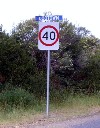 Instead of stopping at Port Arthur, we traveled on for a drive around the Tasman Peninsula to check out the sights, eventually deciding to stop for the night at the White Beach Tourist Park on the outskirt of the township of Nubeena. Hopeful enquiries by the MOTH at the manager’s office regarding a nice restaurant to go for dinner to celebrate my birthday revealed that the RSL Club do not serve meals on Mondays and the nearest pub is several kms away.
Instead of stopping at Port Arthur, we traveled on for a drive around the Tasman Peninsula to check out the sights, eventually deciding to stop for the night at the White Beach Tourist Park on the outskirt of the township of Nubeena. Hopeful enquiries by the MOTH at the manager’s office regarding a nice restaurant to go for dinner to celebrate my birthday revealed that the RSL Club do not serve meals on Mondays and the nearest pub is several kms away.  As the MOTH hopped into the driver’s seat to get to our powered site, the manager raced out of his office to wish me a very happy birthday. How sweet of him! Meanwhile, seeing my poor MOTH in a quandary over somewhere to go for a special dinner, I suggested that we heat up the Rendang that I had brought from home and have that with rice and thought nothing more of it. We quickly hooked up to the power point and eagerly turn on the TV to catch the afternoon play of Day 4 of the cricket match. Blast it!
As the MOTH hopped into the driver’s seat to get to our powered site, the manager raced out of his office to wish me a very happy birthday. How sweet of him! Meanwhile, seeing my poor MOTH in a quandary over somewhere to go for a special dinner, I suggested that we heat up the Rendang that I had brought from home and have that with rice and thought nothing more of it. We quickly hooked up to the power point and eagerly turn on the TV to catch the afternoon play of Day 4 of the cricket match. Blast it!  For some unexplained reason, the Cricket match wasn’t being telecast in this neck of the woods so we had to satisfy ourselves with the ABC radio commentary which was intermittent with a lot of interference from the overhead power lines.
For some unexplained reason, the Cricket match wasn’t being telecast in this neck of the woods so we had to satisfy ourselves with the ABC radio commentary which was intermittent with a lot of interference from the overhead power lines.  Grrrr’ Not having any grandkids with us, we took our transistor radio out instead, for a stroll along the beach of Wedge Bay, just a few short steps from the park but the air smelt pretty foul, not unlike the air of Orford so we cut the beach walk short and made our way back to Just Trip’n by road instead. We eventually deduced the bad odour must be due to the seaweed and dead marine life that had been washed ashore at high tide and then left high and dry to nicely rot away when the tide is out. My MOTH then suggested that we go for a drive as the afternoon was still young. Although somewhat puzzled, I went along with his idea. Why was I puzzled? Well, it’s most unusual for the good man to willingly run around disconnecting the power cord, wind down the TV antenna and so on once we had settled anywhere for the day. I wasn’t exactly brimming with good cheer either as I was so much looking forward to watching a bit of the cricket telecast.
Grrrr’ Not having any grandkids with us, we took our transistor radio out instead, for a stroll along the beach of Wedge Bay, just a few short steps from the park but the air smelt pretty foul, not unlike the air of Orford so we cut the beach walk short and made our way back to Just Trip’n by road instead. We eventually deduced the bad odour must be due to the seaweed and dead marine life that had been washed ashore at high tide and then left high and dry to nicely rot away when the tide is out. My MOTH then suggested that we go for a drive as the afternoon was still young. Although somewhat puzzled, I went along with his idea. Why was I puzzled? Well, it’s most unusual for the good man to willingly run around disconnecting the power cord, wind down the TV antenna and so on once we had settled anywhere for the day. I wasn’t exactly brimming with good cheer either as I was so much looking forward to watching a bit of the cricket telecast.
 As it turned out, unbeknownst to me, he had put on his thinking cap and planned on giving me a little surprise. He was a man on a mission! He drove all the way back to the Tasman Arch car park, some 36km (22 miles) away, to the mobile caf’ where he had seen some nice crays (lobsters) for sale when he bought our lunch.
As it turned out, unbeknownst to me, he had put on his thinking cap and planned on giving me a little surprise. He was a man on a mission! He drove all the way back to the Tasman Arch car park, some 36km (22 miles) away, to the mobile caf’ where he had seen some nice crays (lobsters) for sale when he bought our lunch. 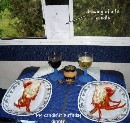 He bought the biggest cray they had for sale and on the way back we stopped at the only supermarket in Nubeena (the Aboriginal word for crayfish), a sleepy little holiday/fishing village which despite its ‘smallness’, is the largest township on the Tasman Peninsula, to get a bottle of Cognac Seafood Cocktail sauce and a couple of individual serves Mixed Berry Cheesecake. By the time we got back to the White Beach Tourist Park, the cricket live telecast was on so we both chilled out with a nice cold drink and watched cricket till it ended for the day. While I was having my shower, my MOTH got busy with cleaning the lobster and had the table set with a glass of champagne for me and a picture of a lit candle that he had hastily drawn and propped up against the window! Indeed I was deeply touched by his sweet gesture. After dessert and coffee, he even did the dishes and refused to let me touch the tea-towel’ What a guy!
He bought the biggest cray they had for sale and on the way back we stopped at the only supermarket in Nubeena (the Aboriginal word for crayfish), a sleepy little holiday/fishing village which despite its ‘smallness’, is the largest township on the Tasman Peninsula, to get a bottle of Cognac Seafood Cocktail sauce and a couple of individual serves Mixed Berry Cheesecake. By the time we got back to the White Beach Tourist Park, the cricket live telecast was on so we both chilled out with a nice cold drink and watched cricket till it ended for the day. While I was having my shower, my MOTH got busy with cleaning the lobster and had the table set with a glass of champagne for me and a picture of a lit candle that he had hastily drawn and propped up against the window! Indeed I was deeply touched by his sweet gesture. After dessert and coffee, he even did the dishes and refused to let me touch the tea-towel’ What a guy!
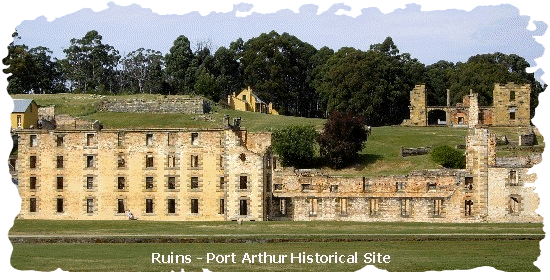
Day 9 Nov 20:
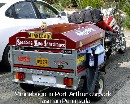 We left the Tourist Park at 9am and headed straight for Port Arthur Historic Site, getting
We left the Tourist Park at 9am and headed straight for Port Arthur Historic Site, getting there about 9.30am. While walking to the site entrance, we spotted an unusual vehicle in the car-park – a Yamaha motorcycle with a little trailer cutely named “Minnebago”, so out came our cameras to take our first photo of the day. We then proceeded to the ticket counter to purchase two tickets (1 senior, 1 adult) as well as the additional tickets necessary for a tour of the Isle of the Dead (originally called Opossum Island), bringing the total to $65. To kill some time before the scheduled 11am harbour cruise, we sauntered around the park until it was time to board the cruise boat. Those with the relevant tickets like us, were dropped off at the jetty at the Isle of The Dead with a guide leading the way for an interesting 40-minute tour of the historic cemetery where about 1100 people were buried according to their
there about 9.30am. While walking to the site entrance, we spotted an unusual vehicle in the car-park – a Yamaha motorcycle with a little trailer cutely named “Minnebago”, so out came our cameras to take our first photo of the day. We then proceeded to the ticket counter to purchase two tickets (1 senior, 1 adult) as well as the additional tickets necessary for a tour of the Isle of the Dead (originally called Opossum Island), bringing the total to $65. To kill some time before the scheduled 11am harbour cruise, we sauntered around the park until it was time to board the cruise boat. Those with the relevant tickets like us, were dropped off at the jetty at the Isle of The Dead with a guide leading the way for an interesting 40-minute tour of the historic cemetery where about 1100 people were buried according to their  station in life – the lower half of the island was reserved for convicts, lunatics, invalids and paupers and the higher ground was reserved for civil and military burials.
station in life – the lower half of the island was reserved for convicts, lunatics, invalids and paupers and the higher ground was reserved for civil and military burials. 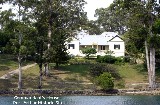 We were picked up by the cruise boat and brought back to the jetty at 12.15pm and at 12.30pm, visitors were divided into two groups before being led off in different directions for a short guided tour of the park. After that ended, we were left to our own devises to explore the park to our hearts’ desire. Man, did we walk! Five and a half hours after our arrival, we both had enough of walking from one site to another – from the Asylum to the gloomy solitary confinement cells, from the Commandant’s House right down to the Convict Church ruins, so we decided to call it a day.
We were picked up by the cruise boat and brought back to the jetty at 12.15pm and at 12.30pm, visitors were divided into two groups before being led off in different directions for a short guided tour of the park. After that ended, we were left to our own devises to explore the park to our hearts’ desire. Man, did we walk! Five and a half hours after our arrival, we both had enough of walking from one site to another – from the Asylum to the gloomy solitary confinement cells, from the Commandant’s House right down to the Convict Church ruins, so we decided to call it a day.  By then, our legs felt like we had been dragging a ball and chain all day and we could hardly wait to get back to the Tourist Park for another night’s stay. By the time we got back to White Beach, the Cricket match was over so we missed out on watching the Aussies beat the Sri Lankans by 96 runs. After a bit of a rest, we did our laundry ($4 to use the washing machine and $3 to use the dryer) and to save some time, we took turns to have a shower while the other spent some exciting time watching our clothes tumbling around in the dryer. Good to know that we won’t have to worry about dirty clothes for another week now. Had dinner of Rendang and rice before settling in for a couple of hours of TV viewing, finally succumbing to sleep before the midnight hour. Tomorrow we will check out the Tasmanian Devil Park before heading south towards Hobart.
By then, our legs felt like we had been dragging a ball and chain all day and we could hardly wait to get back to the Tourist Park for another night’s stay. By the time we got back to White Beach, the Cricket match was over so we missed out on watching the Aussies beat the Sri Lankans by 96 runs. After a bit of a rest, we did our laundry ($4 to use the washing machine and $3 to use the dryer) and to save some time, we took turns to have a shower while the other spent some exciting time watching our clothes tumbling around in the dryer. Good to know that we won’t have to worry about dirty clothes for another week now. Had dinner of Rendang and rice before settling in for a couple of hours of TV viewing, finally succumbing to sleep before the midnight hour. Tomorrow we will check out the Tasmanian Devil Park before heading south towards Hobart.
Day 10 Nov 21:

 We drove out of White Beach at 9am and headed towards Port Arthur to check out Remarkable Cave (so called because if viewed from the correct angle, the mouth of the cave is the same shape as Tasmania), a cave with two openings located at Maingon Bay and accessible only via a steep and narrow set of stairs (someone had obviously counted the number of stairs and wrote ‘116’ on the info sign). The crumpled concertina pattern on the outside of Remarkable Cave was created by dolerite baked on crumpled sandstone as it cooled after being forced toward the Earth’s surface as molton rock. Several photos later, we left the area and drove out of the Tasman Peninsula, back into Forestier Peninsula, only stopping for a photo of a Tudor manor in the Tasmanian bush, the Fox and Hounds Inn.
We drove out of White Beach at 9am and headed towards Port Arthur to check out Remarkable Cave (so called because if viewed from the correct angle, the mouth of the cave is the same shape as Tasmania), a cave with two openings located at Maingon Bay and accessible only via a steep and narrow set of stairs (someone had obviously counted the number of stairs and wrote ‘116’ on the info sign). The crumpled concertina pattern on the outside of Remarkable Cave was created by dolerite baked on crumpled sandstone as it cooled after being forced toward the Earth’s surface as molton rock. Several photos later, we left the area and drove out of the Tasman Peninsula, back into Forestier Peninsula, only stopping for a photo of a Tudor manor in the Tasmanian bush, the Fox and Hounds Inn.
I wanted to see the Tasmanian Devils up close and personal so we went to the Tasmanian Devil Conservation Park situated between Eaglehawk Neck and Dunalley. 
 Entry cost $24pp and included in the entrance fee were viewing of Tasmanian Devils being fed, Kings of the Wind Bird Show (free-flight raptor show) which included the Dive of the Falcon where a falcon flew in from out of nowhere, right between the legs of three volunteers who had been asked to stand with their legs apart, one behind another, much to the amusement of the awestruck spectators. Then there was the thieving white cockatoo who cheekily pinched coins from the hands of visitors and deposited them into his keeper’s pocket.
Entry cost $24pp and included in the entrance fee were viewing of Tasmanian Devils being fed, Kings of the Wind Bird Show (free-flight raptor show) which included the Dive of the Falcon where a falcon flew in from out of nowhere, right between the legs of three volunteers who had been asked to stand with their legs apart, one behind another, much to the amusement of the awestruck spectators. Then there was the thieving white cockatoo who cheekily pinched coins from the hands of visitors and deposited them into his keeper’s pocket. 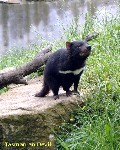 We were introduced to tawny frogmouths which I first mistook to be owls and several other interesting feathered creatures.
We were introduced to tawny frogmouths which I first mistook to be owls and several other interesting feathered creatures.  After the bird show, visitors were free to wander around the park so off we went with our cameras to see more of our feathered friends – from beautiful budgerigars to pretty parrots, some in enclosures and others like the Cape Baron Geese roamed freely all over the place. We walked around a huge paddock that had countless kangaroos and wallabies and it wasn’t long before we got tired of playig the game, “dodge the kangaroo poo”, so we left the Conservation Park and headed off to Dunalley for lunch of crumbed butterfish and chips from Dunalley Fish Market, washed down with a drink of Coke. A few hundred meters up the road after leaving the Fish Market, we began discussing our dinner plan for the evening ‘ ‘Mmm, a crayfish would be nice’’ we mused simultaneously, so the MOTH made a slick U-turn to go back to the Fish Market to buy one.
After the bird show, visitors were free to wander around the park so off we went with our cameras to see more of our feathered friends – from beautiful budgerigars to pretty parrots, some in enclosures and others like the Cape Baron Geese roamed freely all over the place. We walked around a huge paddock that had countless kangaroos and wallabies and it wasn’t long before we got tired of playig the game, “dodge the kangaroo poo”, so we left the Conservation Park and headed off to Dunalley for lunch of crumbed butterfish and chips from Dunalley Fish Market, washed down with a drink of Coke. A few hundred meters up the road after leaving the Fish Market, we began discussing our dinner plan for the evening ‘ ‘Mmm, a crayfish would be nice’’ we mused simultaneously, so the MOTH made a slick U-turn to go back to the Fish Market to buy one.

 From Dunalley, we got onto the Tasman Highway and drove through Sorell to get on the Tasman Bridge over the River Derwent into Hobart, and onto the Channel Highway to Kingston where the MOTH replenished his cash supply at an ATM. We then drove on to Margate, where, in a siding beside the road, stood the last passenger train to run in Tasmania. What a novel way of utilizing an old train! The carriages had been cleverly converted into little shops – a pancake parlour, coffee shop, souvenir stores, etc… a quaint shopping complex known as Margate Train Recreational Shopping and Tourist Development.
From Dunalley, we got onto the Tasman Highway and drove through Sorell to get on the Tasman Bridge over the River Derwent into Hobart, and onto the Channel Highway to Kingston where the MOTH replenished his cash supply at an ATM. We then drove on to Margate, where, in a siding beside the road, stood the last passenger train to run in Tasmania. What a novel way of utilizing an old train! The carriages had been cleverly converted into little shops – a pancake parlour, coffee shop, souvenir stores, etc… a quaint shopping complex known as Margate Train Recreational Shopping and Tourist Development. 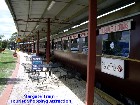 We stopped for a bit of a sticky-beak before continuing our drive on the coastal road through Snug (named because of its quiet and snug surroundings),
We stopped for a bit of a sticky-beak before continuing our drive on the coastal road through Snug (named because of its quiet and snug surroundings),  Kettering (noted for orchards of apples, cherries, pears and also as a regional fishing centre), Woodbridge (another coastal township noted for its orchards) and so on, finally calling it a day at Cygnet, a small town 55km south-west of Hobart, in the Huon Valley. We spent the night at the Cygnet Holiday Park, this place being the most expensive, with a powered site costing $30 a night. It was just as well the water supply in the park was potable as our supply of drinking water had just about run out. We feasted on the crayfish purchased earlier before a relaxing night in front of the TV. Tomorrow we’ll work our way down to Southport, the southernmost part of Tasmania that is accessible by bitumen road.
Kettering (noted for orchards of apples, cherries, pears and also as a regional fishing centre), Woodbridge (another coastal township noted for its orchards) and so on, finally calling it a day at Cygnet, a small town 55km south-west of Hobart, in the Huon Valley. We spent the night at the Cygnet Holiday Park, this place being the most expensive, with a powered site costing $30 a night. It was just as well the water supply in the park was potable as our supply of drinking water had just about run out. We feasted on the crayfish purchased earlier before a relaxing night in front of the TV. Tomorrow we’ll work our way down to Southport, the southernmost part of Tasmania that is accessible by bitumen road.
Day 11 Nov 22:
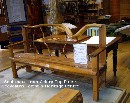
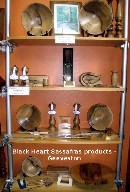 We pulled out of Cygnet at 9am after ‘selling’ the amenities key back to the caretaker for $30 to recoup the deposit we handed him the evening before. We drove up the road a little way to one of the two petrol stations in town to top up on diesel then it was off to Hounville (a town on the Huon River in the Huon Valley best known as one of Tasmania’s primary apple growing areas) to get on the Huon Highway. A stop was made at Geeveston Forest and Heritage Centre for a little tour of the Centre with its interesting display of furniture and various works of art carved from Tasmanian timber. (Geeveston is a small timber and apple growing town in the Huon Valley.)
We pulled out of Cygnet at 9am after ‘selling’ the amenities key back to the caretaker for $30 to recoup the deposit we handed him the evening before. We drove up the road a little way to one of the two petrol stations in town to top up on diesel then it was off to Hounville (a town on the Huon River in the Huon Valley best known as one of Tasmania’s primary apple growing areas) to get on the Huon Highway. A stop was made at Geeveston Forest and Heritage Centre for a little tour of the Centre with its interesting display of furniture and various works of art carved from Tasmanian timber. (Geeveston is a small timber and apple growing town in the Huon Valley.)  My MOTH bought me a ruler – no, not to measure the distance we’ll be travelling, but a souvenir ruler made with sample bits of various Tasmanian timber. We also purchased tickets ($22pp) to enter the Tahune Forest AirWalk and with the 10% discount coupon attached, we stocked up on groceries from the local IGA supermarket across the road. From there, we had a half-hour 28km (17.4 miles) drive on yet another winding road to get to the Tahune Forest AirWalk. [Tahune is an aboriginal word meaning, “peaceful place by running water”, the running water being the Huon River.]
My MOTH bought me a ruler – no, not to measure the distance we’ll be travelling, but a souvenir ruler made with sample bits of various Tasmanian timber. We also purchased tickets ($22pp) to enter the Tahune Forest AirWalk and with the 10% discount coupon attached, we stocked up on groceries from the local IGA supermarket across the road. From there, we had a half-hour 28km (17.4 miles) drive on yet another winding road to get to the Tahune Forest AirWalk. [Tahune is an aboriginal word meaning, “peaceful place by running water”, the running water being the Huon River.]

 It was an awesome experience tackling the super high 597m (1959ft) AirWalk, the highlight being the walk on the 24m (almost 79ft) long cantilever, 48m (157.5ft) above the Huon River. It swayed like a springboard as I nervously walked on it but I was rewarded with fantastic views of the forest canopy and the confluence of the Huon and Picton Rivers with what I believe to be Mt Picton in the background. My MOTH refused to walk on this cantilever and satisfied himself with a photo of me when I got to the very end. With adrenalin still pumping, I readily agreed to go on the 3km Swinging Bridges Circuit one hour walk to cross two swinging bridges, the first one over the Huon River and the second over the Picton River. I found crossing the swinging bridges to be rather daunting but refused to succumb to my trepidation and battled on. I felt a great sense of achievement after my successful swinging bridges crossings and was quite proud of myself. I celebrated with a drink of Coke Zero that I had with me when we reached the last leg of the walk. One minute I was striding along, happy to see the roof of the entrance from the last little hill and next thing I knew, I slipped on the loose gravel, took a downhill dive and landed on my right knee. Man! That was so not fun! Luckily, my camera didn’t hit the ground and I didn’t spill a single drop of my can of drink’ lucky too, that I didn’t tear the right knee of my jeans. With my MOTH’s assistance, I hobbled gingerly over to a nearby bench and surveyed my bloodied knee. I mopped up the blood with some tissues and continued on to the entrance, being careful not to get too much blood on my jeans. We decided against the 30-minute return Huon Trail walk and made our way back to Just Trip’n instead. Some Neosporin’ on my injured knee, a Band-Aid’ over it and I was almost good to go.
It was an awesome experience tackling the super high 597m (1959ft) AirWalk, the highlight being the walk on the 24m (almost 79ft) long cantilever, 48m (157.5ft) above the Huon River. It swayed like a springboard as I nervously walked on it but I was rewarded with fantastic views of the forest canopy and the confluence of the Huon and Picton Rivers with what I believe to be Mt Picton in the background. My MOTH refused to walk on this cantilever and satisfied himself with a photo of me when I got to the very end. With adrenalin still pumping, I readily agreed to go on the 3km Swinging Bridges Circuit one hour walk to cross two swinging bridges, the first one over the Huon River and the second over the Picton River. I found crossing the swinging bridges to be rather daunting but refused to succumb to my trepidation and battled on. I felt a great sense of achievement after my successful swinging bridges crossings and was quite proud of myself. I celebrated with a drink of Coke Zero that I had with me when we reached the last leg of the walk. One minute I was striding along, happy to see the roof of the entrance from the last little hill and next thing I knew, I slipped on the loose gravel, took a downhill dive and landed on my right knee. Man! That was so not fun! Luckily, my camera didn’t hit the ground and I didn’t spill a single drop of my can of drink’ lucky too, that I didn’t tear the right knee of my jeans. With my MOTH’s assistance, I hobbled gingerly over to a nearby bench and surveyed my bloodied knee. I mopped up the blood with some tissues and continued on to the entrance, being careful not to get too much blood on my jeans. We decided against the 30-minute return Huon Trail walk and made our way back to Just Trip’n instead. Some Neosporin’ on my injured knee, a Band-Aid’ over it and I was almost good to go.
 On the way back to Geeveston, on the Arve River Forest Drive, we stopped at the West Creek Lookout for a couple of photos of more trees and treetops and further along, at the Big Tree Lookout, to admire a humongous tree which according to scientific calculations is the biggest, i.e. heaviest tree in Australia, 87m (285.5ft) high and weighing 405 tonnes (446.5 tons). The Big Tree is a Eucalyptus regnans (Regnans means regal) also called a Swamp Gum, the sole survivor of the fires of 1914, 1934 and 1967 and others that had burnt off all the original limbs. Even though the top had blown out and it is dying, it is still regal and magnificent and given the title of ‘Queen without a crown’ by Steve Davis, a forester with 32 years experience in Forestry.
On the way back to Geeveston, on the Arve River Forest Drive, we stopped at the West Creek Lookout for a couple of photos of more trees and treetops and further along, at the Big Tree Lookout, to admire a humongous tree which according to scientific calculations is the biggest, i.e. heaviest tree in Australia, 87m (285.5ft) high and weighing 405 tonnes (446.5 tons). The Big Tree is a Eucalyptus regnans (Regnans means regal) also called a Swamp Gum, the sole survivor of the fires of 1914, 1934 and 1967 and others that had burnt off all the original limbs. Even though the top had blown out and it is dying, it is still regal and magnificent and given the title of ‘Queen without a crown’ by Steve Davis, a forester with 32 years experience in Forestry.
 From there it was back on the Huon Highway, heading south to Southport, the southernmost town accessible by bitumen road. Originally named Bay of Moules by French explorers and Mussel Bay by the English, Southport was founded on Feb 16, 1864 and was the first convict settlement in the Huon region. The region’s local industries are mainly apple-growing, timber and fishing. We spent the night at the Southport Settlement Caravan Park at the CMCA discounted fee of $18 a night for a powered site. I cooked fried rice with leftover roast lamb for our dinner. There had been no contact with our kids all day as there was no mobile phone signal and TV reception was pretty woeful – only one channel with cartoon shows for kids, so we ended up watching a couple of movies on DVDs instead.
From there it was back on the Huon Highway, heading south to Southport, the southernmost town accessible by bitumen road. Originally named Bay of Moules by French explorers and Mussel Bay by the English, Southport was founded on Feb 16, 1864 and was the first convict settlement in the Huon region. The region’s local industries are mainly apple-growing, timber and fishing. We spent the night at the Southport Settlement Caravan Park at the CMCA discounted fee of $18 a night for a powered site. I cooked fried rice with leftover roast lamb for our dinner. There had been no contact with our kids all day as there was no mobile phone signal and TV reception was pretty woeful – only one channel with cartoon shows for kids, so we ended up watching a couple of movies on DVDs instead.
Day 12 Nov 23:

 A few minutes after 8am, we left the Southport Settlement Caravan Park (the southernmost Caravan Park in Tasmania) and drove to the very end of Kingfisher Beach Road (the end of the bitumen road), the site of the prison governor’s house and cell blocks and also the site of the first hotel. I took a photo of Pelican Island (at one time used as a burial ground for the victims of a local diphtheria epidemic) before we left Southport to drive to Hastings.
A few minutes after 8am, we left the Southport Settlement Caravan Park (the southernmost Caravan Park in Tasmania) and drove to the very end of Kingfisher Beach Road (the end of the bitumen road), the site of the prison governor’s house and cell blocks and also the site of the first hotel. I took a photo of Pelican Island (at one time used as a burial ground for the victims of a local diphtheria epidemic) before we left Southport to drive to Hastings.

 Eventually we found our way to Hastings Visitor Centre where we purchased tickets to the Hastings Caves State Reserve. Entry cost $22 per person and included a guided tour of Newdegate Cave and full use of the amenities at Hastings Thermal Springs. I nudged my MOTH to fish out his Seniors Card and as a result, he only paid the Senior discounted fee of $17.60. I must have looked older than my years that day as I was also given the Senior’s discount! No complaints from this old chook though, that’s for sure’
Eventually we found our way to Hastings Visitor Centre where we purchased tickets to the Hastings Caves State Reserve. Entry cost $22 per person and included a guided tour of Newdegate Cave and full use of the amenities at Hastings Thermal Springs. I nudged my MOTH to fish out his Seniors Card and as a result, he only paid the Senior discounted fee of $17.60. I must have looked older than my years that day as I was also given the Senior’s discount! No complaints from this old chook though, that’s for sure’

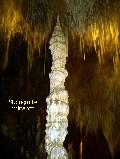 Never having had the experience of a cave tour before, my excitement mounted as we drove along 5km (3 miles) of gravel road to the cave site and as we were way too early for the scheduled 10.15am tour, we decided to enjoy a brunch of sweet chili tuna spread sandwiches in the car-park before the 5 minute downhill walk to the tour rendezvous point at the entrance of Newdegate Cave. The Hastings Caves started forming some 40 million years ago and remained undiscovered until a group of timber workers stumbled upon the entrance in 1917.
Never having had the experience of a cave tour before, my excitement mounted as we drove along 5km (3 miles) of gravel road to the cave site and as we were way too early for the scheduled 10.15am tour, we decided to enjoy a brunch of sweet chili tuna spread sandwiches in the car-park before the 5 minute downhill walk to the tour rendezvous point at the entrance of Newdegate Cave. The Hastings Caves started forming some 40 million years ago and remained undiscovered until a group of timber workers stumbled upon the entrance in 1917.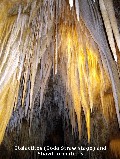 Newdegate Cave is one of only two dolomite caves in Australia and is the largest tourist cave in the country. [The other is on mainland Australia, the Tantanoola Cave near Millicent in South Australia.] It is named after the governor of the time, Sir Francis Newdegate and was officially opened on January 19th, 1939.
Newdegate Cave is one of only two dolomite caves in Australia and is the largest tourist cave in the country. [The other is on mainland Australia, the Tantanoola Cave near Millicent in South Australia.] It is named after the governor of the time, Sir Francis Newdegate and was officially opened on January 19th, 1939.  We enjoyed a 45-minute guided tour of the massive cave filled with spectacular formations of flowstone, stalactites, columns, shawls, straws, stalagmites and rare helictites with the underground temperature naturally maintained at 9oCelsius. The last part of the tour was awesome – we were shown Titania’s Palace – a spectacular wonderland of stalagmites and stalactites which has earned Newdegate Cave a reputation as one of the most beautiful caves in the country. Altogether, we negotiated 245 stairs before we saw daylight again.
We enjoyed a 45-minute guided tour of the massive cave filled with spectacular formations of flowstone, stalactites, columns, shawls, straws, stalagmites and rare helictites with the underground temperature naturally maintained at 9oCelsius. The last part of the tour was awesome – we were shown Titania’s Palace – a spectacular wonderland of stalagmites and stalactites which has earned Newdegate Cave a reputation as one of the most beautiful caves in the country. Altogether, we negotiated 245 stairs before we saw daylight again.

 After the cave tour, it was back to the Hastings Visitor Centre for the 100mtrs (110yds) forest walk along the Hot Springs Track. When we got to the “Hot Meets Cold” information archway marking the convergence of two streams, we put our hands in the water to feel the warm current from one stream meeting with the cold current from the other. The warm spring water is alkaline, clear, with a bluish tinge and only slightly mineralised whilst the cold water is acidic and “tea” coloured from natural tannins. Both streams are pollution-free. We continued strolling along the designated walkway through the forest,
After the cave tour, it was back to the Hastings Visitor Centre for the 100mtrs (110yds) forest walk along the Hot Springs Track. When we got to the “Hot Meets Cold” information archway marking the convergence of two streams, we put our hands in the water to feel the warm current from one stream meeting with the cold current from the other. The warm spring water is alkaline, clear, with a bluish tinge and only slightly mineralised whilst the cold water is acidic and “tea” coloured from natural tannins. Both streams are pollution-free. We continued strolling along the designated walkway through the forest, 
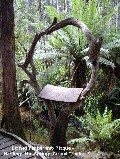 stopping now and again to read the various informative plaques, some cleverly etched into timber. At the end of our walk, we admired the surrounds of the Thermal Springs Pool (constant temperature of 27o Celsius) which is set in bushland with modern picnic facilities in a picturesque BBQ area. What a pity we didn’t have our swimming gear with us… It is believed that the Hastings Thermal Springs is a karst water system that may be linked to that at Newdegate Cave. From Hastings, it was another winding road drive over hills and vales on the Huon
stopping now and again to read the various informative plaques, some cleverly etched into timber. At the end of our walk, we admired the surrounds of the Thermal Springs Pool (constant temperature of 27o Celsius) which is set in bushland with modern picnic facilities in a picturesque BBQ area. What a pity we didn’t have our swimming gear with us… It is believed that the Hastings Thermal Springs is a karst water system that may be linked to that at Newdegate Cave. From Hastings, it was another winding road drive over hills and vales on the Huon Highway through Dover, Glendevie, Geeveston and various townships stopping at Franklin to utilize the grey water dumping station. Then it was on to Huonville to check out the Wood Cutter sculpture on the bank of the Huon River as mentioned in the sheet of visitor guide I was clutching. Only problem being the absence of a town map of Huonville to guide us…
Highway through Dover, Glendevie, Geeveston and various townships stopping at Franklin to utilize the grey water dumping station. Then it was on to Huonville to check out the Wood Cutter sculpture on the bank of the Huon River as mentioned in the sheet of visitor guide I was clutching. Only problem being the absence of a town map of Huonville to guide us…
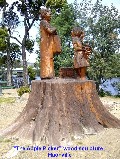 Originally, the land on which Huonville is now located was privately owned and it wasn’t until 1889 that the town became known as Huonville. The town is
Originally, the land on which Huonville is now located was privately owned and it wasn’t until 1889 that the town became known as Huonville. The town is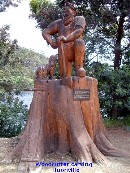 situated on fairly flat land a couple of metres above the mean level of the Huon River. Every decade or two the river rises and floods part of the town. The locals then cover up the road signs declaring the place to be “Huonville” and replace them with the word “Venice” until the water subsides again. The construction of the first timber bridge over the Huon River in 1876 cost ‘4400 – it was a toll bridge charging 2 pence for walkers and 6 pence for horses. The original timber bridge was replaced in 1926 and the present steel and concrete structure was completed in 1959. In the old days, the town was nothing more than the Picnic Hotel and a couple of shops along the river. The Picnic Hotel burnt down and was subsequently rebuilt as the Grand Hotel which still stands near the bridge. [It is in the background of the photo of the soldier wood sculpture.]
situated on fairly flat land a couple of metres above the mean level of the Huon River. Every decade or two the river rises and floods part of the town. The locals then cover up the road signs declaring the place to be “Huonville” and replace them with the word “Venice” until the water subsides again. The construction of the first timber bridge over the Huon River in 1876 cost ‘4400 – it was a toll bridge charging 2 pence for walkers and 6 pence for horses. The original timber bridge was replaced in 1926 and the present steel and concrete structure was completed in 1959. In the old days, the town was nothing more than the Picnic Hotel and a couple of shops along the river. The Picnic Hotel burnt down and was subsequently rebuilt as the Grand Hotel which still stands near the bridge. [It is in the background of the photo of the soldier wood sculpture.]
While my MOTH drove as slowly as he could, traffic permitting, my eyes darted 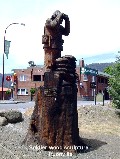 all over the place desperately looking for the wood sculpture. I eventually spotted it, along with a couple of other sculptures, just as we were on the verge of giving up.
all over the place desperately looking for the wood sculpture. I eventually spotted it, along with a couple of other sculptures, just as we were on the verge of giving up.  There they stood in Short Street, just over the Huon Highway bridge! I gleefully leapt out of Just Trip’n to take a few photos while my MOTH waited patiently behind the wheel. The Short Family had planted trees in 1902 to commemorate the local volunteers and one hundred years later, at the end of the safe life of the trees, the figures were sculptured from the stumps of the trees to maintain the historic links. Sculpture of “The Wood Cutter” depicts a typical Huon pioneer of the 1800s, “The Apple Picker” is dedicated to the women pioneers of the Huon Valley and the sculpture of a soldier commemorates the local men who volunteered for service in the Boer War.
There they stood in Short Street, just over the Huon Highway bridge! I gleefully leapt out of Just Trip’n to take a few photos while my MOTH waited patiently behind the wheel. The Short Family had planted trees in 1902 to commemorate the local volunteers and one hundred years later, at the end of the safe life of the trees, the figures were sculptured from the stumps of the trees to maintain the historic links. Sculpture of “The Wood Cutter” depicts a typical Huon pioneer of the 1800s, “The Apple Picker” is dedicated to the women pioneers of the Huon Valley and the sculpture of a soldier commemorates the local men who volunteered for service in the Boer War.
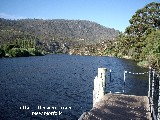
 From Huonville, we went on the Channel Highway to drive through Cygnet and Oyster Cove before stopping at the seaside town of Snug to indulge in possibly the last feed of fresh Tasmanian Crays as we would be leaving the coastline tomorrow and heading inland, through the centre of the island. We decided to really pig out by getting a full cray each. Our next stop was Meredith Fruit Barn in Margate to get a couple of avocados, a few pears and several mandarins before driving through Hobart on the Brooker Highway to get to New Norfolk to spend the night at the New Norfolk Esplanade Caravan Park, situated close to the Derwent River (Celtic meaning ‘Clear Water’) at $20 a night.
From Huonville, we went on the Channel Highway to drive through Cygnet and Oyster Cove before stopping at the seaside town of Snug to indulge in possibly the last feed of fresh Tasmanian Crays as we would be leaving the coastline tomorrow and heading inland, through the centre of the island. We decided to really pig out by getting a full cray each. Our next stop was Meredith Fruit Barn in Margate to get a couple of avocados, a few pears and several mandarins before driving through Hobart on the Brooker Highway to get to New Norfolk to spend the night at the New Norfolk Esplanade Caravan Park, situated close to the Derwent River (Celtic meaning ‘Clear Water’) at $20 a night.

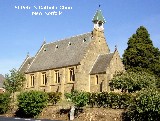 New Norfolk is one of the oldest towns in Australia, originally called Elizabeth Town and re-named by the settlers from Norfolk Island in 1807 when the island’s prison was closed down. It is the centre of the hop-growing area which has produced hops for over a century and supplies the majority of the hops used in the production of Tasmanian beer. By this stage of our trip, we had developed a taste for Maille’ Cognac Seafood Cocktail Sauce which enhanced the flavour of the crays we had eaten recently and with very little left to enjoy with the crays we had bought, we decided to go for a ‘short’ walk UPHILL to get to the town centre in search of a supermarket to get another jar of the sauce. We walked for what seemed like hours as we had misread the visitors’ town map and overshot the street leading to the town centre, so we had to back-pedal a block and a half. Found the only supermarket in the town centre but alas, we came out empty-handed! At least the walk back was much more pleasant as it was all downhill, passing the Bush Inn, St Peters Catholic Church and the Old Colony Inn.
New Norfolk is one of the oldest towns in Australia, originally called Elizabeth Town and re-named by the settlers from Norfolk Island in 1807 when the island’s prison was closed down. It is the centre of the hop-growing area which has produced hops for over a century and supplies the majority of the hops used in the production of Tasmanian beer. By this stage of our trip, we had developed a taste for Maille’ Cognac Seafood Cocktail Sauce which enhanced the flavour of the crays we had eaten recently and with very little left to enjoy with the crays we had bought, we decided to go for a ‘short’ walk UPHILL to get to the town centre in search of a supermarket to get another jar of the sauce. We walked for what seemed like hours as we had misread the visitors’ town map and overshot the street leading to the town centre, so we had to back-pedal a block and a half. Found the only supermarket in the town centre but alas, we came out empty-handed! At least the walk back was much more pleasant as it was all downhill, passing the Bush Inn, St Peters Catholic Church and the Old Colony Inn.
 The Bush Inn was built by one of the area’s early enterprising women, Ann Bridger and mentioned in the 1985 Guiness Book of Records as the oldest continuously licensed hotel in Australia. St. Peter’s Catholic Church is an old stone building boasting a magnificent spire against the backdrop of the Derwent hills.
The Bush Inn was built by one of the area’s early enterprising women, Ann Bridger and mentioned in the 1985 Guiness Book of Records as the oldest continuously licensed hotel in Australia. St. Peter’s Catholic Church is an old stone building boasting a magnificent spire against the backdrop of the Derwent hills. 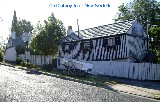 Then we came to the historic Old Colony Inn which started out as a hop shed in 1815 and later extended with a mud and stone lower floor and a convict brick upper floor to become a private dwelling. Over the years, the building has served as a school, gymnasium and barracks, until 1940 when William Rees, an antique dealer and artist, bought the property and developed it into The Old Colony Inn of today. By the time we got back to Just Trip’n, we were more than ready for a refreshing shower before sitting down to feast on our crays with half an avocado apiece and a side of tossed salad. We were both too full for dessert and today’s activities had tired us both out to the point where we actually looked forward to an early night!
Then we came to the historic Old Colony Inn which started out as a hop shed in 1815 and later extended with a mud and stone lower floor and a convict brick upper floor to become a private dwelling. Over the years, the building has served as a school, gymnasium and barracks, until 1940 when William Rees, an antique dealer and artist, bought the property and developed it into The Old Colony Inn of today. By the time we got back to Just Trip’n, we were more than ready for a refreshing shower before sitting down to feast on our crays with half an avocado apiece and a side of tossed salad. We were both too full for dessert and today’s activities had tired us both out to the point where we actually looked forward to an early night!

